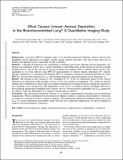What Causes Uneven Aerosol Deposition in the Bronchoconstricted Lung? A Quantitative Imaging Study
Author(s)
Winkler, Tilo; Harris, Robert Scott; Kelly, Vanessa Jane; Kone, Mamary; Katz, Ira; Martin, Andrew R.; Caillibotte, George; Venegas, Jose; Greenblatt, Elliot; ... Show more Show less
Downloadjamp.2014.1197.pdf (1.352Mb)
PUBLISHER_POLICY
Publisher Policy
Article is made available in accordance with the publisher's policy and may be subject to US copyright law. Please refer to the publisher's site for terms of use.
Terms of use
Metadata
Show full item recordAbstract
BACKGROUND: A previous PET-CT imaging study of 14 bronchoconstricted asthmatic subjects showed that peripheral aerosol deposition was highly variable among subjects and lobes. The aim of this work was to identify and quantify factors responsible for this variability. METHODS: A theoretical framework was formulated to integrate four factors affecting aerosol deposition: differences in ventilation, in how air vs. aerosol distribute at each bifurcation, in the fraction of aerosol escaping feeding airways, and in the fraction of aerosol reaching the periphery that is exhaled. These factors were quantified in 12 of the subjects using PET-CT measurements of relative specific deposition sD*, relative specific ventilation sV* (measured with dynamic PET or estimated as change in expansion between two static HRCTs), average lobar expansion FVOL, and breathing frequency measured during aerosol inhalation fN. RESULTS: The fraction of the variance of sD* explained by sV* (0.38), by bifurcation effects (0.38), and by differences in deposition along feeding airways (0.31) were similar in magnitude. We could not directly estimate the contribution of aerosol that was exhaled. Differences in expansion did not explain any fraction of the variability in sD* among lobes. The dependence of sD* on sV* was high in subjects breathing with low fN, but weakened among those breathing faster. Finally, sD*/sV* showed positive dependence on FVOL among low fN subjects, while the dependence was negative among high fN subjects. CONCLUSION: The theoretical framework allowed us to analyze experimentally measured aerosol deposition imaging data. When considering bronchoconstricted asthmatic subjects, a dynamic measurement of ventilation is required to evaluate its effect on aerosol transport. The mechanisms behind the identified effects of fN and FVOL on aerosol deposition need further study and may have important implications for aerosol therapy in subjects with heterogeneous ventilation. Keywords: aerosol deposition; asthma; bronchoconstriction; escape fractions; sedimentation; ventilation
Date issued
2016-01Department
Massachusetts Institute of Technology. Department of Mechanical EngineeringJournal
Journal of Aerosol Medicine and Pulmonary Drug Delivery
Publisher
Mary Ann Liebert
Citation
Greenblatt, Elliot Eliyahu et al. “What Causes Uneven Aerosol Deposition in the Bronchoconstricted Lung? A Quantitative Imaging Study.” Journal of Aerosol Medicine and Pulmonary Drug Delivery 29, 1 (January 2016): 57-75
© 2016 Mary Ann Liebert, Inc
Version: Final published version
ISSN
1941-2711
1941-2703